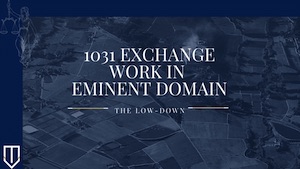
As if eminent domain is not bad enough, after you’ve gone through the process, the government wants to tax you on the land it made you sell. Savvy property owners, however, can limit their tax liabilities through the use of a 1031 exchange process.
Can a property owner limit the effects of eminent domain?
Internal Revenue Code section 1033 permits the owner of property taken by eminent domain to avoid income tax liability by purchasing qualified replacement property within a specified time following the condemnation.
This means that the recognition of any gain realized in connection with the amount paid for the condemned property is deferred to a later time.
Effectively, the “cost basis” of the property taken through eminent domain is transferred to the replacement property, and the gain is recognized only at a later time as the replacement property is sold or transferred.
Additionally, when that property owner dies, and the heirs take the property, there may never be any recognition of any gain.
What Is the Timeline to Buy Replacement Property for an Eminent Domain 1031 Exchange?
To qualify, however, the owner must acquire the replacement property relatively quickly.
Notably, the replacement period begins as soon as the property owner has a right to all or part of the condemnation award, and the replacement period continues to run during litigation regarding compensation. (see I.R.C. § 1033(a)(2).)
Otherwise, the replacement period begins on the date that the property is first threatened with condemnation and ends three years after the end of the first tax year in which any gain is realized. (see I.R.C. § 1033(g).)
Interestingly, the property owner can use the money from the condemned property for more than one replacement property. (see Rev. Rul. 58-396, 1958-2 C.B. 403.)
Conversely, a property owner who loses two properties to an eminent domain can replace them with just one qualified piece of real estate. (Masser v. C.I.R. (T.C. 1958) 30 T.C. 741, 746-747.)
What Qualifies as Replacement Property for an Eminent Domain 1031 Exchange?
One limitation, however, is that the new property purchased with the money from the property taken by eminent domain must “qualify” as replacement property.
The two tests are the “like-kind” test and the “similar service” test. When the taken property is used for business or as an investment, then the “like-kind” test applies. (See I.R.C. § 1033(g)(1).)
When the taken property is used for personal purposes, then the “similar service” test applies. (see I.R.C. § 1033(a).)
Conclusion
The 1031 Exchange can be a powerful tool in eminent domain to limit the tax consequences from the government’s taking of private property. In order to take advantage of it, however, the property owner should seek counsel about the best ways to do so.
If you are faced with an eminent domain proceeding and would like assistance navigating the process, please contact Underwood Law Firm, P.C. for an initial consultation.
Go here to get more details.
 California Partition Law Blog
California Partition Law Blog

